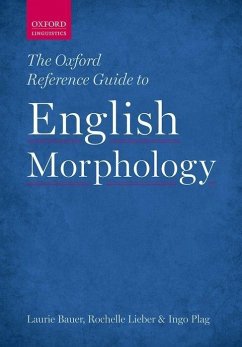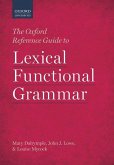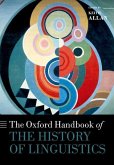- Gebundenes Buch
- Merkliste
- Auf die Merkliste
- Bewerten Bewerten
- Teilen
- Produkt teilen
- Produkterinnerung
- Produkterinnerung
The first comprehensive description of English word formation covers inflection and derivation, compounding, conversion, and minor processes such as subtractive morphology. It combines theory-neutral presentation of data with theoretically informed analysis. Written by three outstanding scholars, this is a vital reference resource for all linguists.
Andere Kunden interessierten sich auch für
![The Oxford Reference Guide to Lexical Functional Grammar The Oxford Reference Guide to Lexical Functional Grammar]() Mary DalrympleThe Oxford Reference Guide to Lexical Functional Grammar220,99 €
Mary DalrympleThe Oxford Reference Guide to Lexical Functional Grammar220,99 €![The Oxford Introduction to Proto-Indo-European and the Proto-Indo-European World The Oxford Introduction to Proto-Indo-European and the Proto-Indo-European World]() J P MalloryThe Oxford Introduction to Proto-Indo-European and the Proto-Indo-European World175,99 €
J P MalloryThe Oxford Introduction to Proto-Indo-European and the Proto-Indo-European World175,99 €![Oxford Guide to Middle High German Oxford Guide to Middle High German]() Howard JonesOxford Guide to Middle High German189,99 €
Howard JonesOxford Guide to Middle High German189,99 €![Oxford Handbook of the History of Linguistics Oxford Handbook of the History of Linguistics]() Oxford Handbook of the History of Linguistics211,99 €
Oxford Handbook of the History of Linguistics211,99 €![Oxford Handbook of Grammaticalization Oxford Handbook of Grammaticalization]() Oxford Handbook of Grammaticalization231,99 €
Oxford Handbook of Grammaticalization231,99 €![The Oxford Guide to the Languages of the Central Andes The Oxford Guide to the Languages of the Central Andes]() The Oxford Guide to the Languages of the Central Andes225,99 €
The Oxford Guide to the Languages of the Central Andes225,99 €![The Oxford Guide to the Transeurasian Languages The Oxford Guide to the Transeurasian Languages]() The Oxford Guide to the Transeurasian Languages235,99 €
The Oxford Guide to the Transeurasian Languages235,99 €-
-
-
The first comprehensive description of English word formation covers inflection and derivation, compounding, conversion, and minor processes such as subtractive morphology. It combines theory-neutral presentation of data with theoretically informed analysis. Written by three outstanding scholars, this is a vital reference resource for all linguists.
Produktdetails
- Produktdetails
- Verlag: Oxford University Press (UK)
- Seitenzahl: 702
- Erscheinungstermin: 1. Oktober 2013
- Englisch
- Abmessung: 249mm x 175mm x 46mm
- Gewicht: 1397g
- ISBN-13: 9780199579266
- ISBN-10: 0199579261
- Artikelnr.: 37313369
- Herstellerkennzeichnung
- Libri GmbH
- Europaallee 1
- 36244 Bad Hersfeld
- gpsr@libri.de
- Verlag: Oxford University Press (UK)
- Seitenzahl: 702
- Erscheinungstermin: 1. Oktober 2013
- Englisch
- Abmessung: 249mm x 175mm x 46mm
- Gewicht: 1397g
- ISBN-13: 9780199579266
- ISBN-10: 0199579261
- Artikelnr.: 37313369
- Herstellerkennzeichnung
- Libri GmbH
- Europaallee 1
- 36244 Bad Hersfeld
- gpsr@libri.de
Laurie Bauer is Professor of Linguistics at Victoria University of Wellington. His books include English Word-formation (CUP 1983), Introducing Linguistic Morphology (2nd edn EUP 2003), Morphological Productivity (CUP 2001) and A Glossary of Morphology (EUP 2004). He is one of the editors of the journal Word Structure. Rochelle Lieber is Professor of Linguistics at the University of New Hampshire and author of Deconstructing Morphology (Chicago 1992), Morphology and Lexical Semantics (CUP 2004), and Introducing Morphology (CUP 2009). She is co-editor with Pavol Stekauer of the Oxford Handbooks of Compounding and Derivational Morphology (OUP 2009 and 2013). Ingo Plag is Professor of English Language and Linguistics at the Heinrich Heine University, Düsseldorf. His books include Morphological Productivity (Mouton de Gruyter 1999), Word-formation in English (CUP 2003), and Introduction to English Linguistics (with co-authors, Mouton de Gruyter 2009). He is co-editor of the journal Morphology.
Part I - Introduction
1: Aims and Structures
2: Basic principles: terminology
3: Basic principles: methods
4: Orthography
Part II - Inflection
5: Verb inflection
6: Adjective and adverb inflection
7: Noun inflection
8: Function words: pronouns, determiners, why-forms, deictics
Part III - Derivation
9: Derivation: phonological considerations
10: Derived nouns: event, state, result
11: Derived nouns: personal and participant
12: Derived nouns: quality, collective, and other abstracts
13: Derived verbs
14: Derived adjectives
15: Derived adverbs
16: Locatives of time and space
17: Negatives
18: Size, quantity, and attitude
Part IV Compounding
19: Compounds: formal considerations
20: Compounds: semantic considerations
Part V Interaction
21: Combination of affixes
22: Affi xation on compounds and phrases
23: Paradigmatic processes
Part VI Themes
24: Inflection versus derivation
25: The analysis and limits of conversion
26: Blocking, competition, and productivity
27: The nature of stratifi cation
28: English morphology in a typological perspective
29: English morphology and theories of morphology
References
Index of affixes and other formatives
Index of names
Index of subjects
1: Aims and Structures
2: Basic principles: terminology
3: Basic principles: methods
4: Orthography
Part II - Inflection
5: Verb inflection
6: Adjective and adverb inflection
7: Noun inflection
8: Function words: pronouns, determiners, why-forms, deictics
Part III - Derivation
9: Derivation: phonological considerations
10: Derived nouns: event, state, result
11: Derived nouns: personal and participant
12: Derived nouns: quality, collective, and other abstracts
13: Derived verbs
14: Derived adjectives
15: Derived adverbs
16: Locatives of time and space
17: Negatives
18: Size, quantity, and attitude
Part IV Compounding
19: Compounds: formal considerations
20: Compounds: semantic considerations
Part V Interaction
21: Combination of affixes
22: Affi xation on compounds and phrases
23: Paradigmatic processes
Part VI Themes
24: Inflection versus derivation
25: The analysis and limits of conversion
26: Blocking, competition, and productivity
27: The nature of stratifi cation
28: English morphology in a typological perspective
29: English morphology and theories of morphology
References
Index of affixes and other formatives
Index of names
Index of subjects
Part I - Introduction
1: Aims and Structures
2: Basic principles: terminology
3: Basic principles: methods
4: Orthography
Part II - Inflection
5: Verb inflection
6: Adjective and adverb inflection
7: Noun inflection
8: Function words: pronouns, determiners, why-forms, deictics
Part III - Derivation
9: Derivation: phonological considerations
10: Derived nouns: event, state, result
11: Derived nouns: personal and participant
12: Derived nouns: quality, collective, and other abstracts
13: Derived verbs
14: Derived adjectives
15: Derived adverbs
16: Locatives of time and space
17: Negatives
18: Size, quantity, and attitude
Part IV Compounding
19: Compounds: formal considerations
20: Compounds: semantic considerations
Part V Interaction
21: Combination of affixes
22: Affi xation on compounds and phrases
23: Paradigmatic processes
Part VI Themes
24: Inflection versus derivation
25: The analysis and limits of conversion
26: Blocking, competition, and productivity
27: The nature of stratifi cation
28: English morphology in a typological perspective
29: English morphology and theories of morphology
References
Index of affixes and other formatives
Index of names
Index of subjects
1: Aims and Structures
2: Basic principles: terminology
3: Basic principles: methods
4: Orthography
Part II - Inflection
5: Verb inflection
6: Adjective and adverb inflection
7: Noun inflection
8: Function words: pronouns, determiners, why-forms, deictics
Part III - Derivation
9: Derivation: phonological considerations
10: Derived nouns: event, state, result
11: Derived nouns: personal and participant
12: Derived nouns: quality, collective, and other abstracts
13: Derived verbs
14: Derived adjectives
15: Derived adverbs
16: Locatives of time and space
17: Negatives
18: Size, quantity, and attitude
Part IV Compounding
19: Compounds: formal considerations
20: Compounds: semantic considerations
Part V Interaction
21: Combination of affixes
22: Affi xation on compounds and phrases
23: Paradigmatic processes
Part VI Themes
24: Inflection versus derivation
25: The analysis and limits of conversion
26: Blocking, competition, and productivity
27: The nature of stratifi cation
28: English morphology in a typological perspective
29: English morphology and theories of morphology
References
Index of affixes and other formatives
Index of names
Index of subjects








